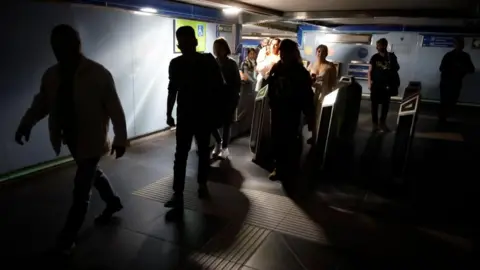On April 28, 2025, an extensive power outage struck Spain and Portugal, leading to significant disruptions across various sectors, including transportation, commerce, and daily life. This unprecedented blackout has left a mark on the lives of citizens in these two Iberian nations, showcased vividly by a series of poignant photographs that illustrate the chaos that unfolded.
The outages predominantly affected major cities, including Madrid and Lisbon, where the loss of electricity had immediate repercussions. Airports, train services, and petrol stations were among the most obvious casualties of this widespread power failure. Commutes were disrupted, with networks like Spain’s national rail company, Renfe, reporting severe impacts on train services and passenger travel. In a striking image, commuters were captured sitting outside the closed Atocha train station in Madrid, showcasing the depth of the disruption as people sought alternatives for their journeys.
Supermarkets faced immediate operational challenges as their cash registers were rendered inoperable due to the loss of power. Many grocery stores had to pivot to cash-only transactions, forcing shoppers to queue at ATMs to withdraw necessary funds. Photographs from Lisbon reveal long lines forming at cash machines in the downtown area, underscoring the public’s scramble for access to cash as electronic payments ceased to function.
Scenes of confusion and unrest were omnipresent. Crowds amassed outside various public transport hubs, attempting to secure rides on commuter buses, while a massive traffic jam unfolded in cities like Madrid due to the non-functioning traffic signals. These chaotic visuals were emblematic of a day that became a logistical nightmare for countless residents attempting to navigate inaccessible public transportation systems amid soaring urban traffic.
In the face of grocery stores shutting down for safety reasons—their air conditioning and security systems dependent on electricity—people exhibited resourcefulness, with one poignant image capturing a person shopping using the flashlight functionality of a mobile phone. Such images highlighted not only the inconvenience brought about by the blackout but also the resilience of individuals in dire situations.
The blackouts were not limited to urban centers but also affected smaller towns, where residents reported challenges related to accessing basic necessities. With their refrigerators inactive and no way to cook, many individuals were seen resorting to outdoor cooking methods. Some managed to acquire gas bottles to maintain some semblance of normalcy, ensuring they had means to prepare food during the outage.
Furthermore, the latest updates indicated that the power outage extended throughout the afternoon and into the evening, contributing to rising tensions among residents through misinformation about the outage’s duration. Warnings from officials prompted residents to exercise caution, as the overall impact began to draw widespread scrutiny and questions regarding the resilience of power infrastructure in both countries.
Through a collection of powerful photographs, the unfolding story of the power disruptions is not only illustrated but also poignantly told. These snapshots serve as a reminder of our vulnerability to unforeseen circumstances and the critical importance of infrastructure stability. They document everyday moments abruptly altered, as people resorted to alternative means to communicate, travel, and shop amid the chaos.
In summary, the power outage in Spain and Portugal has starkly highlighted the intricacies of modern societal dependencies on electricity, illuminating a day of crisis characterized by moments of chaos and resilience. As both nations work to restore normalcy, citizens reflect on the disruptions and the ways their lives were temporarily upended. The images captured throughout this turbulent period will undoubtedly serve as historical artifacts chronicling an unprecedented challenge faced by Spain and Portugal.



